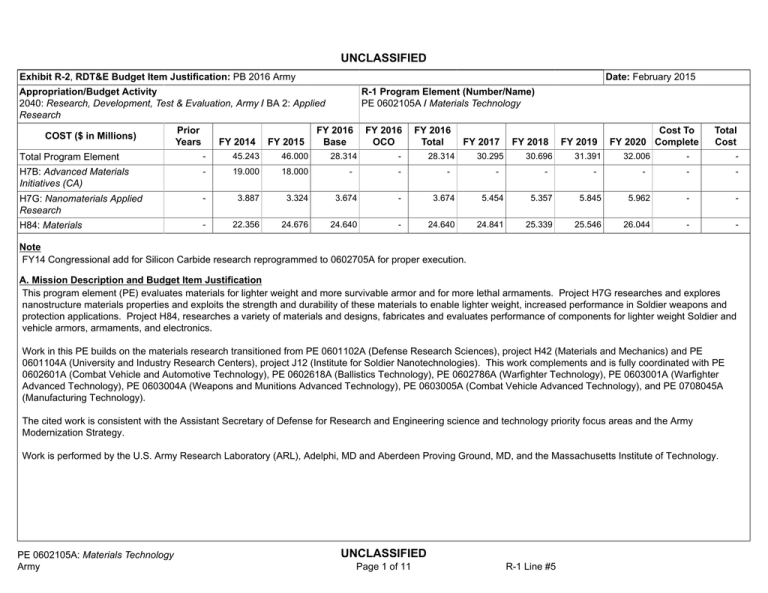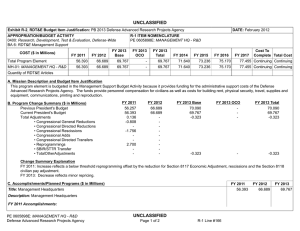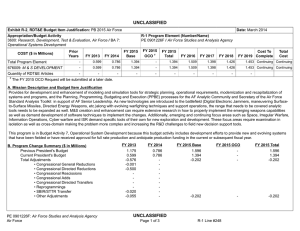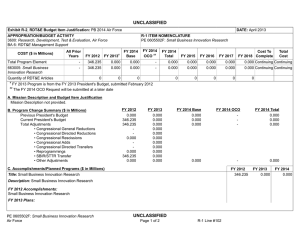UNCLASSIFIED
advertisement

UNCLASSIFIED Date: February 2015 Exhibit R-2, RDT&E Budget Item Justification: PB 2016 Army Appropriation/Budget Activity 2040: Research, Development, Test & Evaluation, Army / BA 2: Applied Research COST ($ in Millions) Prior Years FY 2014 FY 2015 R-1 Program Element (Number/Name) PE 0602105A / Materials Technology FY 2016 Base FY 2016 OCO FY 2016 Total FY 2017 FY 2018 FY 2019 Cost To FY 2020 Complete Total Cost Total Program Element - 45.243 46.000 28.314 - 28.314 30.295 30.696 31.391 32.006 - - H7B: Advanced Materials Initiatives (CA) - 19.000 18.000 - - - - - - - - - H7G: Nanomaterials Applied Research - 3.887 3.324 3.674 - 3.674 5.454 5.357 5.845 5.962 - - H84: Materials - 22.356 24.676 24.640 - 24.640 24.841 25.339 25.546 26.044 - - Note FY14 Congressional add for Silicon Carbide research reprogrammed to 0602705A for proper execution. A. Mission Description and Budget Item Justification This program element (PE) evaluates materials for lighter weight and more survivable armor and for more lethal armaments. Project H7G researches and explores nanostructure materials properties and exploits the strength and durability of these materials to enable lighter weight, increased performance in Soldier weapons and protection applications. Project H84, researches a variety of materials and designs, fabricates and evaluates performance of components for lighter weight Soldier and vehicle armors, armaments, and electronics. Work in this PE builds on the materials research transitioned from PE 0601102A (Defense Research Sciences), project H42 (Materials and Mechanics) and PE 0601104A (University and Industry Research Centers), project J12 (Institute for Soldier Nanotechnologies). This work complements and is fully coordinated with PE 0602601A (Combat Vehicle and Automotive Technology), PE 0602618A (Ballistics Technology), PE 0602786A (Warfighter Technology), PE 0603001A (Warfighter Advanced Technology), PE 0603004A (Weapons and Munitions Advanced Technology), PE 0603005A (Combat Vehicle Advanced Technology), and PE 0708045A (Manufacturing Technology). The cited work is consistent with the Assistant Secretary of Defense for Research and Engineering science and technology priority focus areas and the Army Modernization Strategy. Work is performed by the U.S. Army Research Laboratory (ARL), Adelphi, MD and Aberdeen Proving Ground, MD, and the Massachusetts Institute of Technology. PE 0602105A: Materials Technology Army UNCLASSIFIED Page 1 of 11 R-1 Line #5 UNCLASSIFIED Date: February 2015 Exhibit R-2, RDT&E Budget Item Justification: PB 2016 Army Appropriation/Budget Activity 2040: Research, Development, Test & Evaluation, Army / BA 2: Applied Research FY 2014 B. Program Change Summary ($ in Millions) Previous President's Budget Current President's Budget Total Adjustments • Congressional General Reductions • Congressional Directed Reductions • Congressional Rescissions • Congressional Adds • Congressional Directed Transfers • Reprogrammings • SBIR/STTR Transfer • Adjustments to Budget Years 55.569 45.243 -10.326 - - - - - -10.000 -0.326 - R-1 Program Element (Number/Name) PE 0602105A / Materials Technology FY 2015 FY 2016 Base FY 2016 OCO FY 2016 Total 28.006 46.000 17.994 -0.006 - - 18.000 - - - - 28.481 28.314 -0.167 - - - 28.481 28.314 -0.167 -0.167 - -0.167 Congressional Add Details ($ in Millions, and Includes General Reductions) Project: H7B: Advanced Materials Initiatives (CA) FY 2014 Congressional Add: Nanotechnology Research 4.000 - 15.000 - - 18.000 Congressional Add Subtotals for Project: H7B 19.000 18.000 Congressional Add Totals for all Projects 19.000 18.000 Congressional Add: Materials Research Congressional Add: Program Increase PE 0602105A: Materials Technology Army UNCLASSIFIED Page 2 of 11 FY 2015 R-1 Line #5 UNCLASSIFIED Date: February 2015 Exhibit R-2A, RDT&E Project Justification: PB 2016 Army Appropriation/Budget Activity 2040 / 2 COST ($ in Millions) R-1 Program Element (Number/Name) PE 0602105A / Materials Technology Prior Years H7B: Advanced Materials Initiatives (CA) FY 2014 - FY 2015 19.000 18.000 FY 2016 Base FY 2016 OCO - FY 2016 Total - FY 2017 - - Project (Number/Name) H7B / Advanced Materials Initiatives (CA) FY 2018 - FY 2019 - Note Not applicable for this item. A. Mission Description and Budget Item Justification Congressional Interest Item funding provided for Advanced Materials Initiatives. B. Accomplishments/Planned Programs ($ in Millions) FY 2014 FY 2015 4.000 - Congressional Add: Nanotechnology Research FY 2014 Accomplishments: This is a Congressional Interest Item. Designed an adaptation of methodology and processes that creates the foundation for environmentally controlled facilities for computer processing and consolidation of large nano-material products using nano-structured aluminum and copper alloys. Developed adaptive and production scalable methodology to enable rapid processing of nano-coating, stable bulk nanoperform and stable near-net-shape components. Congressional Add: Materials Research 15.000 - - 18.000 19.000 18.000 FY 2014 Accomplishments: This is a Congressional Interest Item. Designed a multi-scale modeling capability for bulk material and component modeling; established magneto-thermodynamics and other mathematical expressions describing fundamental laws in paramagnetic, diamagnetic, and ferromagnetic matter to further discover non-equilibrium, metastable, transformational, and otherwise currently non-existent matter and apply them to manufacturing science, modeling, and simulation innovations. Congressional Add: Program Increase FY 2015 Plans: Program increase for materials research Congressional Adds Subtotals C. Other Program Funding Summary ($ in Millions) N/A Remarks PE 0602105A: Materials Technology Army UNCLASSIFIED Page 3 of 11 R-1 Line #5 Cost To FY 2020 Complete - - Total Cost - UNCLASSIFIED Date: February 2015 Exhibit R-2A, RDT&E Project Justification: PB 2016 Army Appropriation/Budget Activity 2040 / 2 R-1 Program Element (Number/Name) PE 0602105A / Materials Technology D. Acquisition Strategy N/A E. Performance Metrics N/A PE 0602105A: Materials Technology Army UNCLASSIFIED Page 4 of 11 R-1 Line #5 Project (Number/Name) H7B / Advanced Materials Initiatives (CA) UNCLASSIFIED Date: February 2015 Exhibit R-2A, RDT&E Project Justification: PB 2016 Army Appropriation/Budget Activity 2040 / 2 COST ($ in Millions) R-1 Program Element (Number/Name) PE 0602105A / Materials Technology Prior Years H7G: Nanomaterials Applied Research FY 2014 - FY 2015 3.887 3.324 FY 2016 Base FY 2016 OCO 3.674 FY 2016 Total - 3.674 FY 2017 5.454 FY 2018 Project (Number/Name) H7G / Nanomaterials Applied Research FY 2019 5.357 5.845 Cost To FY 2020 Complete 5.962 Total Cost - - Note Not applicable for this item. A. Mission Description and Budget Item Justification This effort conducts nanoscience research relevant to the Soldier focused on new materials, properties and phenomena in five research areas: (1) lightweight, multifunctional nanostructured materials and hybrid assemblies, (2) soldier medicine, (3) multiple blast and ballistic threats, (4) hazardous substances sensing, recognition, and protection, and (5) nanosystem integration for protected communications, diagnostic sensing, and operational flexibility in complex environments. This project funds collaborative applied research and integration of government, academic, and industry scientific research on nanomaterials derived from PE 0601104A/ project J12 (Institute for Soldier Nanotechnologies (ISN)) to advance innovative capabilities. This project sustains Army science and technology efforts supporting the Soldier portfolio. Work in this project builds on the materials research transitioned from PE 0601104A. This work complements and is fully coordinated with PE 0602618A (Ballistics Technology), PE 0602786A (Warfighter Technology), and PE 0603001A (Warfighter Advanced Technology). The cited work is consistent with the Assistant Secretary of Defense for Research and Engineering science and technology priority focus areas and the Army Modernization Strategy. Work in this project is performed by the U.S. Army Research Laboratory (ARL), Adelphi, MD and Aberdeen Proving Ground, MD, the Massachusetts Institute of Technology, and the ISN industrial partners. B. Accomplishments/Planned Programs ($ in Millions) FY 2014 3.887 Title: Nanomaterials Applied Research Description: Devise and validate improved physics-based, materials property models and concepts for multifunctional, lightweight, and responsive materials. Exploit breakthroughs in nanomaterials and multifunctional fiber processing technologies, such as scale-up of processes and fabrication into woven materials,) to enable revolutionary future Soldier capabilities. FY 2014 Accomplishments: PE 0602105A: Materials Technology Army UNCLASSIFIED Page 5 of 11 R-1 Line #5 FY 2015 3.324 FY 2016 3.674 UNCLASSIFIED Date: February 2015 Exhibit R-2A, RDT&E Project Justification: PB 2016 Army Appropriation/Budget Activity 2040 / 2 R-1 Program Element (Number/Name) PE 0602105A / Materials Technology Project (Number/Name) H7G / Nanomaterials Applied Research B. Accomplishments/Planned Programs ($ in Millions) Developed quantum dot-based optical taggant system to enable daylight visible tag, track, and locate (TTL) and combat identification capabilities; validated hydrophobic and antimicrobial coating technology on fabrics; and validated high rate response of nanometallic aluminum alloys for use in lightweight protection systems. FY 2014 FY 2015 FY 2016 FY 2015 Plans: Develop new materials capable of selective energy absorption based on novel coating technologies using nano- and microparticles; synthesize unique molecules for use as additives in transparent eye protection materials that simultaneously solve processing issues and enhance material performance; and demonstrate stability and performance of a daylight visible taggant system based on a quantum dot-enabled paint for covert tracking and combat identification applications. FY 2016 Plans: Will develop nano-structured protective materials and associated processing capabilities to enable novel light-weight materials solutions with enhanced impact performance; and develop novel nano-materials that enable sensing and communication platforms through the use and optimization of size-dependent properties (e.g., quantum confinement) for detection and nontraditional communications. Accomplishments/Planned Programs Subtotals C. Other Program Funding Summary ($ in Millions) N/A Remarks D. Acquisition Strategy N/A E. Performance Metrics N/A PE 0602105A: Materials Technology Army UNCLASSIFIED Page 6 of 11 R-1 Line #5 3.887 3.324 3.674 UNCLASSIFIED Date: February 2015 Exhibit R-2A, RDT&E Project Justification: PB 2016 Army Appropriation/Budget Activity 2040 / 2 COST ($ in Millions) H84: Materials R-1 Program Element (Number/Name) PE 0602105A / Materials Technology Prior Years FY 2014 - FY 2015 22.356 24.676 FY 2016 Base FY 2016 OCO 24.640 FY 2016 Total - FY 2017 24.640 24.841 Project (Number/Name) H84 / Materials FY 2018 25.339 FY 2019 25.546 Cost To FY 2020 Complete 26.044 Total Cost - - Note Not applicable for this item. A. Mission Description and Budget Item Justification This project designs, fabricates, and evaluates a variety of materials (e.g. metals, ceramics, polymers, and composites) that have potential to enable more survivable, lighter weight Soldier and vehicle armor, chemical and biological protection, armaments, and electronics. Research conducted focuses on unique and/or novel material properties, developing physics-based models, materials characterization techniques, non-destructive testing methods and advanced fabrication/processing methodologies. This project sustains Army science and technology efforts supporting the Ground Maneuver, Lethality, and Soldier portfolios. Work in this project makes extensive use of high performance computing and experimental validation and builds on research transitioned from PE 0601102A (Defense Research Sciences), project H42 (Materials and Mechanics), and project H43 (Ballistics). The work complements and is fully coordinated with efforts in PE 0602601A (Combat Vehicle and Automotive Technology), PE 0602618A (Survivability and Lethality Technologies), PE 0602786A (Warfighter Technology), PE 0603001A (Warfighter Advanced Technology), PE 0603004A (Weapons and Munitions Advanced Technology), PE 0603005A (Combat Vehicle Advanced Technology), and PE 0708045A (Manufacturing Technology). The cited work is consistent with the Assistant Secretary of Defense for Research and Engineering science and technology priority focus areas and the Army Modernization Strategy. The work is conducted by the U.S. Army Research Laboratory (ARL) at Aberdeen Proving Ground, MD. B. Accomplishments/Planned Programs ($ in Millions) FY 2014 2.460 Title: Structural Armor Materials Description: Conduct applied research to design and evaluate lightweight armor materials and structures, investigate novel processing methodologies for cost effective manufacturing, and use existing and emerging modeling and simulation tools to enable formulation of lightweight, frontal, and structural armor materials for current and future platform applications. FY 2014 Accomplishments: Determined relationships between electronic signals from non-destructive characterization tools and microscopically observed structural details in ceramic armor materials; developed analysis algorithms used for modeling, process feedback and ballistic characteristics; developed aluminum alloys for blast and penetration resistance, emphasizing full scale fabrication for alloy PE 0602105A: Materials Technology Army UNCLASSIFIED Page 7 of 11 R-1 Line #5 FY 2015 5.412 FY 2016 5.289 UNCLASSIFIED Date: February 2015 Exhibit R-2A, RDT&E Project Justification: PB 2016 Army Appropriation/Budget Activity 2040 / 2 R-1 Program Element (Number/Name) PE 0602105A / Materials Technology Project (Number/Name) H84 / Materials B. Accomplishments/Planned Programs ($ in Millions) chemistries optimized for the most beneficial metallurgical, mechanical and formability characteristics; and developed novel processing strategies for polymer compositions to enable tunable mechanical response; and applied processing science, modeling, and simulation to validate processing technology for the metallic encapsulation of ceramic armor tiles. FY 2014 FY 2015 FY 2016 FY 2015 Plans: Develop improved delamination resistance and damage tolerance of thick composites using innovative, cost-effective manufacturing concepts; demonstrate ballistic performance of monolithic baseline magnesium (Mg) alloy and layered ceramic/Mg alloy/ultra-high-molecular-weight polyethylene (UHMWPE) sandwich structure variants with weight reduction goal of 5-12% over current designs; develop validated physics-based models for fatigue of Mg alloy structures for lightweight vehicles that eliminate traditional empirical modeling approaches; and validate novel algorithms to identify links between the microstructure of armor ceramics and ballistic performance, enabling both screening of as-processed tiles as well as development of next generation armor ceramics. FY 2016 Plans: Will advance the manufacturing science of magnesium alloys using specific combinations of processing techniques to impart unique structure and achieve large, high performance plates for armor applications; mature development of damage tolerance concepts for thick composites through refinement of novel experimental and simulation strategies that enable material property and performance optimization through control of processing parameters; investigate multiscale structure-property relationships and construct predictive characterization schemes with an aim to influence manufacturability of preferred properties. Title: Soldier-Borne Armor Materials 5.339 Description: Utilizing understanding of defeat mechanisms from PE 0602618A/project H80, conduct applied research of emerging lightweight armor materials and structures to enable affordable design of multifunctional ballistic protective systems for the future Soldier. Provide quantitative scientific basis for modeling and simulation that result in materials that utilize new lethal mechanisms/protection schemes for the individual Warfighter. FY 2014 Accomplishments: Developed synthesis and processing routes for low density boron-based ceramic compositions, provided model validation using high resolution electron microscopy; developed soft polymers through computational methods and experimental validation to match the rate dependent response of relevant human tissues; developed a robust fiber ballistic modeling tool to investigate penetration resistance of up to 10 layers of 2D fabric with multiple fiber or material architectures and validated the model with ballistic testing; developed a refined process model to describe the deformation characteristics and fiber-matrix adhesion; and provided experimental validation of the model. FY 2015 Plans: PE 0602105A: Materials Technology Army UNCLASSIFIED Page 8 of 11 R-1 Line #5 5.402 5.348 UNCLASSIFIED Date: February 2015 Exhibit R-2A, RDT&E Project Justification: PB 2016 Army Appropriation/Budget Activity 2040 / 2 R-1 Program Element (Number/Name) PE 0602105A / Materials Technology Project (Number/Name) H84 / Materials B. Accomplishments/Planned Programs ($ in Millions) Develop a filament-level 3D textile model for use in the development of soft body armor; develop and characterize new materials for extremity armor; and develop validated numerical modeling capability to analyze new materials for the range of personnel protection options that utilize the inherent multifunctional nature of composite materials to enhance survivability. FY 2014 FY 2015 FY 2016 FY 2016 Plans: Will develop lab-scale processing approaches for boron-based ceramics using dopants and glassy films to achieve dramatic toughness improvements; investigate energy absorption improvements in helmet padding materials; and develop a validated multi-physics model predicting microstructure and residual stress in ultra high molecular weight polyethylene (UHMWPE) composites as a function of process history to enable improvements in material properties through process optimization. Title: Lethality Materials Technology (formerly named Composites) 2.900 4.494 4.483 9.872 7.458 7.554 Description: For FY15, this effort formerly known as Composites is being renamed Lethality Materials Technology to more accurately describe the research being conducted. This effort involves applied research to develop innovative materials solutions aimed at achieving leap-ahead increases in lethality and weapons effectiveness through dramatic improvements in weight and volume efficiency, lethal effects, and sustainability of military systems that can only be achieved through advances in materials technology. FY 2014 Accomplishments: Validated improved multi-hit ballistic capability of three-dimensional, through-thickness reinforced (3D-TTR) hybridized composite test coupons; through the use of computational and experimental methods, designed and prepared polymer resins derived from renewable sources that provide properties at least equivalent to conventionally prepared polyether ether ketone (PEEK); and developed materials models and experimental techniques to validate >50% improvement in the adhesion of dissimilar materials used in vehicle protection platforms. FY 2015 Plans: Develop metal matrix composites to meet thermal requirements of gun barrels at reduced weight; utilize a combination of consolidation and diffusion processes to create nanostructured copper materials for coatings/liners that enable reduction in shape charge jet size while maintaining jet effect; and explore interfacial/bonding effects on the coupled and high loading rate failure modes in thermoplastic composites. FY 2016 Plans: Will advance understanding of metal-based gun barrel materials by establishing wear properties and exploring active cooling technologies; determine properties and liner performance of nanostructured copper-based materials; and investigate alternative lower-cost compositions that will provide improved shape charge jet formation and performance of the liner. Title: Multifunctional Armor Materials PE 0602105A: Materials Technology Army UNCLASSIFIED Page 9 of 11 R-1 Line #5 UNCLASSIFIED Date: February 2015 Exhibit R-2A, RDT&E Project Justification: PB 2016 Army Appropriation/Budget Activity 2040 / 2 R-1 Program Element (Number/Name) PE 0602105A / Materials Technology Project (Number/Name) H84 / Materials B. Accomplishments/Planned Programs ($ in Millions) FY 2014 FY 2015 FY 2016 Description: This effort researches novel multifunctional armor materials for Army applications such as structural energy storage, armor embedded command, control and communications (C3) antennas, and self healing materials. Soldier personnel protection materials transition to PE 0602786A/project H98. Reactive armor and electromagnetic armor materials transition to PE 0602618A/ project H80 and PE 0602601A/project C05. FY 2014 Accomplishments: Researched comprehensive armor materials technologies which include multifunctional batteries and/or capacitors (combined structural armor/power storage materials); supported total armor materials development via formulation of chemical agent resistive coatings (CARC) to reduce corrosion, improve decontamination, and lessen solar loading; assessed non-local theory and numerical methods for the failure of complex materials subjected to strong electromagnetic fields and validated with experiments; and determined synthetic viability of novel third generation chromophores for use in thick polymer laser protective materials. FY 2015 Plans: Validate new embedded power and enhanced survivability capabilities in multifunctional composite materials using enhanced modeling and processing techniques; develop new additive manufacturing capabilities using three dimensional (3-D) printing, cold spray, and/or related techniques to explore methods for low-volume production and expand design space (e.g., bio-inspired protection concepts); establish electric field effects on select ceramics and metals to enable Electric Field Assisted Sintering (EFAS) of new multifunctional materials; and identify inelastic deformation mechanisms as a function of strain rate in silicon carbide armor ceramics through development of novel experimental techniques. FY 2016 Plans: Will mature the additive manufacturing and processing of multi-component materials and develop a new simulation tool that links process science to the desired materials structure and properties; investigate the use of electromagnetic (EM) fields to control and optimize microstructure in metals and ceramics used in armor applications; evaluate the formation of ceramic materials through the use of low temperature solidification processing using locally sourced materials; and investigate and characterize peptides (that act as glue in natural/biological materials in warm moist environments) with a goal of demonstrating triple the lifetime and strength in high humidity conditions. Title: Nanomaterials 1.785 Description: Mature and scale-up nanomaterials processes, fabrication, characterization and performance measures to enable revolutionary concepts for future force lethality and survivability beyond those addressed for individual Soldier protection in PE 062105A/project H7G. FY 2014 Accomplishments: Developed thermally stable, dispersible nanocrystalline cellulose for use in transparent materials to improve the stiffness by 25% without optical penalty; developed powder production technology for reliable, cost effective production of domestic PE 0602105A: Materials Technology Army UNCLASSIFIED Page 10 of 11 R-1 Line #5 1.910 1.966 UNCLASSIFIED Date: February 2015 Exhibit R-2A, RDT&E Project Justification: PB 2016 Army Appropriation/Budget Activity 2040 / 2 R-1 Program Element (Number/Name) PE 0602105A / Materials Technology Project (Number/Name) H84 / Materials B. Accomplishments/Planned Programs ($ in Millions) nanocrystalline tungsten; identified tungsten carbide microstructures and properties for rigid body penetration of armor; and developed environmentally friendly binder materials for tungsten carbide. FY 2014 FY 2015 FY 2016 FY 2015 Plans: Develop thermally stable nanocrystalline cellulous particles and networks for incorporation into impact resistant transparent polymers used for personnel protection; establish bulk mechanical properties of thermally stabilized nanocrystalline alloys to expand design space for structural and armor applications; and synthesize novel third generation chromophores and incorporate into thick polymer materials used in anti-laser sensor protection devices. FY 2016 Plans: Will develop nanocellulose-based fibers with surface modifications for improved toughness and demonstrate improved impact strength in nanocellulose composites; investigate scaled-up fabrication of thermally stable iron-based nanomaterials with enhanced strength and ductility; and determine performance capabilities of nanostructure copper-based shaped charge liners. Accomplishments/Planned Programs Subtotals C. Other Program Funding Summary ($ in Millions) N/A Remarks D. Acquisition Strategy N/A E. Performance Metrics N/A PE 0602105A: Materials Technology Army UNCLASSIFIED Page 11 of 11 R-1 Line #5 22.356 24.676 24.640



